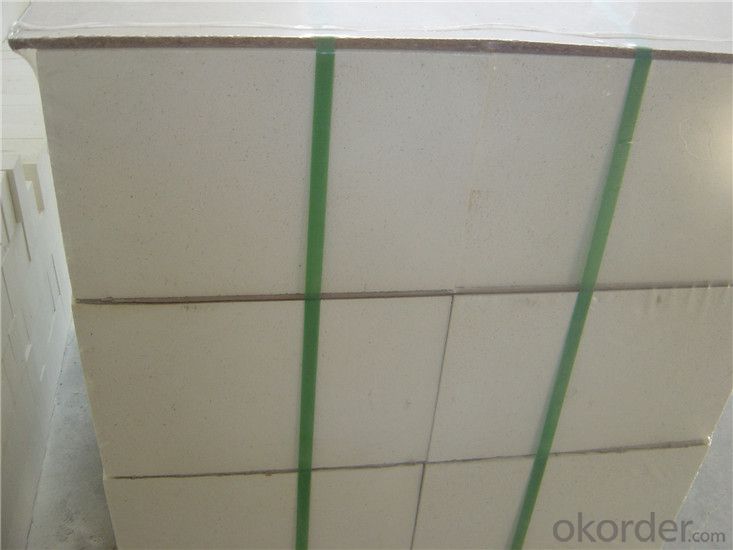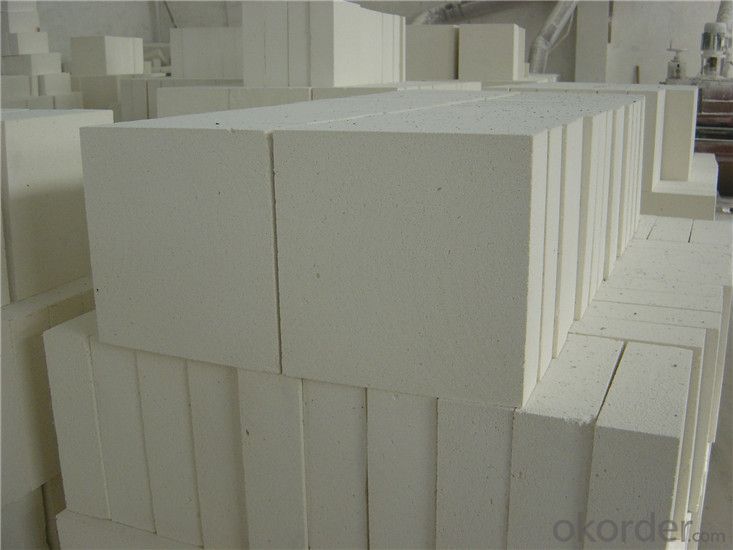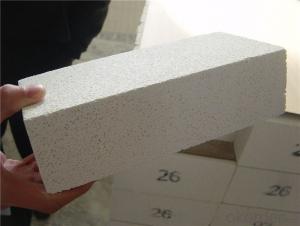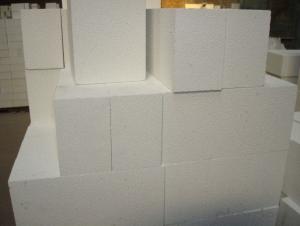Insulating Brick Insulation Brick Mullite Brick
- Loading Port:
- Shanghai
- Payment Terms:
- TT OR LC
- Min Order Qty:
- 1 m.t.
- Supply Capability:
- 1000 m.t./month
OKorder Service Pledge
OKorder Financial Service
You Might Also Like
CNBM conforms strictly to the requirements of ISO 9000 quality control system during the production. MSDS is also available if you want. The thermal insulation fire clay brick meet with the requirements of ASTM & JIS standards. So please stay cool with our quality.
Application
Insulating Fire Brick are used for the lining of converter, alternating current arc furnace, direct Current arc furnace and the ladle slag line, etc.
Insulating Fire Brick Technical index
Brand Quality | JM23 | JM26 | JM28 | JM30 | JM32 | |
Bulk Density (g/cm3) | 0.52 | 0.78 | 0.88 | 1.03 | 1.25 | |
1.2 | 1.6 | 2.1 | 2.5 | 3.5 | ||
Modulus of Rupture (Mpa) | 0.9 | 1.4 | 1.6 | 2.1 | 2.1 | |
-0.5 | 1400℃ -0.4 | 1510℃ -0.5 | 1620℃ -0.9 | 1730℃ -0.9 | ||
Thermal Expansion 1100℃(%) |
0.5 |
0.7 |
0.8 |
0.9 |
1.1 | |
Thermal conductivity(W/m.k)
| 400℃ | 0.14 | 0.27 | 0.32 | 0.41 | 0.49 |
600℃ | 0.16 | 0.29 | 0.34 | 0.43 | 0.50 | |
800℃ | 0.18 | 0.31 | 0.36 | 0.44 | 0.51 | |
1000℃ | 0.20 | 0.33 | 0.38 | 0.45 | 0.53 | |
Al2O3 | 37 | 58 | 67 | 73 | 77 | |
Fe2O3 | 0.7 | 0.7 | 0.6 | 0.5 | 0.4 | |
Equipment
1 unit of Ceramic Abrasive (SG Abrasive) pilot production line
2 units of Compact grain Abrasive pilot production lines
1 unit of high-end coated abrasives (abrasive cloth) production line
2 units of Boron Carbide production lines
3 large flexible crushing and sieving lines for grit production lines
2 units of 2000KVA furnaces for Boron Carbide fusion
6 units of 5000KVA-10000KVA dumping type electric arc furnaces for Brown Fused Alumina fusion
Company Advantage
(1)Long Insulating Fire Brick manufacture history: 25 years manufacturer
(2)Advanced equipment
(3)Diversification of production standards: ISO ANSI FEPA JIS ASTM
(4)Flexible payment: T/T L/C D/P D/A
(5)Professional marketing team and after-sale service
(6)Free sample


- Q:What kind of material is clay insulation refractory brick made of?
- According to the different origin of general clay brick raw materials are not the same with Henan or Hebei with perlite beads, pyrojewel, use effect and technology of Henan is better than Hebei
- Q:Can insulating fire bricks be used in low-temperature applications as well?
- Yes, insulating fire bricks can be used in low-temperature applications. These bricks are designed to have low thermal conductivity, making them suitable for retaining heat and insulating against temperature fluctuations. They can effectively withstand lower temperatures while still providing insulation and preventing heat loss.
- Q:Can insulating fire bricks be used in thermal oxidizers?
- Insulating fire bricks are indeed applicable for thermal oxidizers. These bricks are specifically designed to possess low thermal conductivity, enabling them to effectively diminish heat transfer and conserve energy in high-temperature scenarios. Thermal oxidizers, on the other hand, are utilized as devices for treating industrial exhaust gases through the process of oxidizing pollutants at elevated temperatures. By incorporating insulating fire bricks into the construction of thermal oxidizers, the system can confine heat within, ensuring efficient combustion while minimizing heat loss to the surrounding environment. Consequently, this not only enhances the overall thermal efficiency of the thermal oxidizer but also aids in decreasing energy consumption and operational expenses. Furthermore, insulating fire bricks possess remarkable resistance against thermal shock and display exceptional insulating properties, rendering them suitable for the challenging and rigorous conditions commonly encountered in thermal oxidizers.
- Q:What is the typical weight of an insulating fire brick?
- The typical weight of an insulating fire brick can vary depending on its size and composition, but it typically ranges from 2 to 4 pounds (0.9 to 1.8 kilograms).
- Q:How do insulating fire bricks help reduce heat loss through conduction?
- Insulating fire bricks are designed to minimize heat loss through conduction by utilizing their unique properties. These bricks are made from a special type of lightweight refractory material, such as ceramic fibers or a combination of high-alumina and silica, which have low thermal conductivity. The low thermal conductivity of insulating fire bricks helps to reduce heat transfer by conduction. When heat is applied to one side of the brick, the low thermal conductivity of the material prevents the rapid transfer of heat to the other side. This means that less heat is lost through the brick via conduction, resulting in improved insulation and energy efficiency. Furthermore, insulating fire bricks often have a high porosity, which creates air pockets within the material. These air pockets act as barriers to heat transfer, as air is a poor conductor of heat. By trapping air within the brick's structure, the insulating fire brick effectively slows down the movement of heat, further reducing heat loss through conduction. Additionally, insulating fire bricks have a high melting point, allowing them to withstand extreme temperatures without deforming or breaking down. This property ensures that the bricks can effectively insulate against heat transfer even in high-temperature environments, such as furnaces or kilns. In summary, insulating fire bricks help reduce heat loss through conduction by virtue of their low thermal conductivity, high porosity, and high melting point. These bricks effectively limit the transfer of heat from one side to the other, minimizing energy loss and improving insulation efficiency.
- Q:Can insulating fire bricks be used in a refractory lining?
- Yes, insulating fire bricks can be used in a refractory lining. Insulating fire bricks are made from lightweight materials and have high insulating properties, which make them suitable for use in refractory linings to reduce heat loss and improve energy efficiency.
- Q:Can insulating fire bricks be used for insulation in ovens?
- Yes, insulating fire bricks can be used for insulation in ovens. These bricks are designed to withstand high temperatures and are highly effective in retaining heat, making them ideal for insulating ovens and other high-temperature applications.
- Q:Can insulating fire bricks be used as a refractory material?
- Yes, insulating fire bricks can be used as a refractory material. Insulating fire bricks are specifically designed to withstand high temperatures and thermal shock, making them suitable for applications that require heat insulation and refractory properties. They have low thermal conductivity, which helps to reduce heat loss and conserve energy. Insulating fire bricks are commonly used in various industries, including steel, glass, ceramics, and petrochemicals, where they are used as lining materials in furnaces, kilns, ovens, and other high-temperature equipment. Their ability to withstand extreme temperatures, coupled with their insulating properties, makes them an excellent choice for refractory applications.
- Q:Can insulating fire bricks be used in refractory lining applications?
- Yes, insulating fire bricks can be used in refractory lining applications. Insulating fire bricks are made from lightweight materials that have high insulating properties, such as clay or silica. These bricks are designed to provide excellent thermal insulation, reducing heat loss and improving energy efficiency in high-temperature applications. In refractory lining applications, insulating fire bricks are commonly used to line the walls, floors, and roofs of furnaces, boilers, kilns, and other industrial equipment. They are effective in preventing heat transfer to the surrounding environment and maintaining the desired temperature inside the equipment. Insulating fire bricks are also resistant to thermal shock, meaning they can withstand rapid changes in temperature without cracking or failing. This makes them suitable for applications where the equipment goes through frequent heating and cooling cycles. Furthermore, insulating fire bricks have low thermal conductivity, which means they can effectively limit heat transfer between different areas of the refractory lining. This helps to prevent hot spots and temperature imbalances, ensuring uniform heat distribution throughout the equipment. Overall, insulating fire bricks are a versatile and effective choice for refractory lining applications, providing excellent thermal insulation, resistance to thermal shock, and uniform heat distribution.
- Q:Can insulating fire bricks be used in the construction of flue liners?
- Yes, insulating fire bricks can be used in the construction of flue liners. Insulating fire bricks are designed to withstand high temperatures and provide excellent insulation properties. These bricks are made from lightweight materials such as vermiculite or perlite, which have low thermal conductivity. This makes them ideal for lining flues, as they can help to retain heat and improve the efficiency of the flue system. Additionally, insulating fire bricks are resistant to thermal shock and can withstand rapid temperature changes, which is important in flue applications where the temperatures can fluctuate significantly. Overall, using insulating fire bricks in the construction of flue liners can help to enhance the performance and safety of the flue system.
1. Manufacturer Overview |
|
|---|---|
| Location | |
| Year Established | |
| Annual Output Value | |
| Main Markets | |
| Company Certifications | |
2. Manufacturer Certificates |
|
|---|---|
| a) Certification Name | |
| Range | |
| Reference | |
| Validity Period | |
3. Manufacturer Capability |
|
|---|---|
| a)Trade Capacity | |
| Nearest Port | |
| Export Percentage | |
| No.of Employees in Trade Department | |
| Language Spoken: | |
| b)Factory Information | |
| Factory Size: | |
| No. of Production Lines | |
| Contract Manufacturing | |
| Product Price Range | |
Send your message to us
Insulating Brick Insulation Brick Mullite Brick
- Loading Port:
- Shanghai
- Payment Terms:
- TT OR LC
- Min Order Qty:
- 1 m.t.
- Supply Capability:
- 1000 m.t./month
OKorder Service Pledge
OKorder Financial Service
Similar products
New products
Hot products
Related keywords



























